Split Jerk: Technique, Benefits & Common Mistakes
Author:
Unlock your full potential by engaging with our experts and community! Have questions about your fitness journey or looking for expert advice on weightlifting techniques? Don’t hesitate — leave a comment below and Oleksiy Torokhtiy will provide a personalized answer and insights to help you reach your goals.
Torokhtiy is reader-supported. Some links are affiliate links, and we may earn a commission at no extra cost to you. See our disclosure page for details.
Anyone that’s looking to amp up their strength and athletic performance should have the split jerk in their training routine. When you see it, it kind of looks like you’re just supposed to lift a heavy weight over your head, but the split jerk is far more than that – it’s a full-body exercise that builds power, speed, and coordination.
Today, we’ll guide you through the split jerk workout, give you step-by-step instructions on how to do it, tell you all about the benefits and we’ll even throw in some variations and alternatives so you don’t get bored.
Ready to up your lifting game? Keep reading!
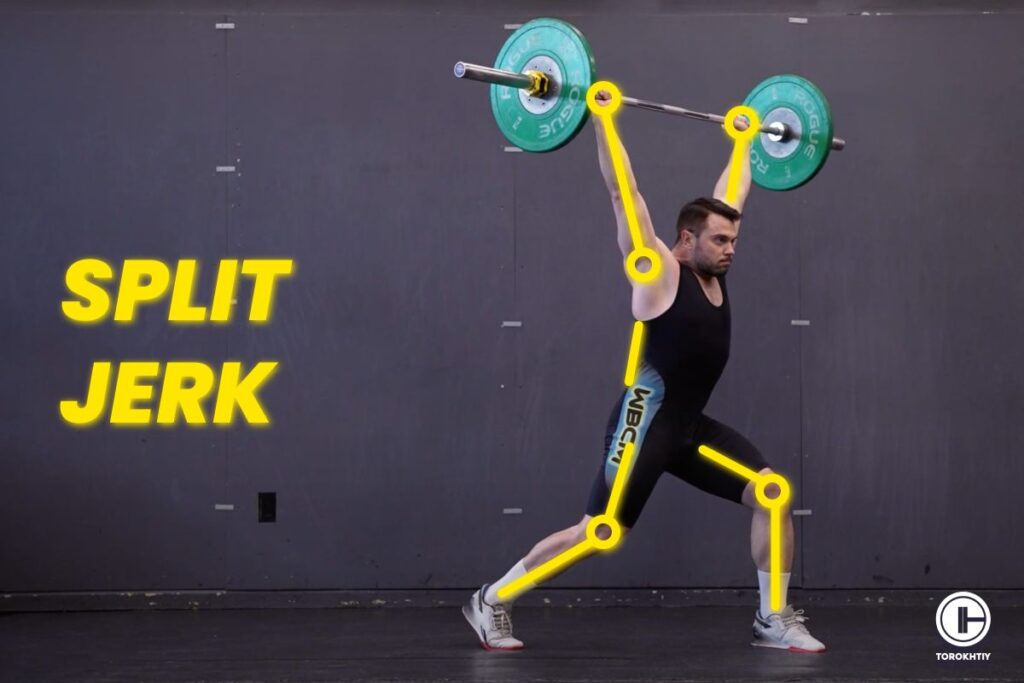
What Is the Split Jerk?
The split jerk is a dynamic Olympic weightlifting exercise where you explosively lift the barbell from shoulder height to overhead while splitting your legs into a split stance. Its main purpose is to allow you to lift heavier weights overhead with greater stability and control.
When you split the legs, you get a more stable base, so it’s easier to balance and support the weight. This exercise tests your strength, but it also improves it over time. Apart from strength, it will also improve your speed, coordination, and balance.
How to Do the Split Jerk?
Let’s see how to split jerk properly! It might seem a bit intimidating, but once we break it into steps, you’ll see it’s not that bad.
1. Starting Position
You can’t do it properly without a good split jerk stance.
Stand with your feet hip-width apart and the bar resting on your shoulders. Make sure your chest is up and the back is straight. Grip the bar slightly wider than shoulder-width, with your elbows pointing forward, not directly to the sides.
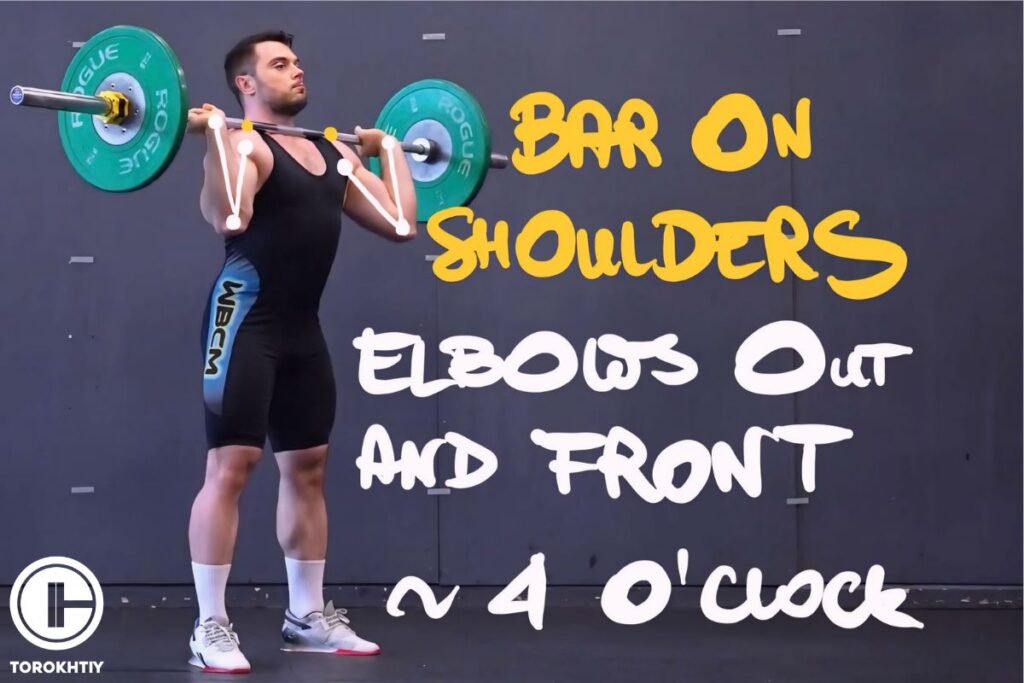
2. Dip
Bend your hips and knees a little and lower your body a few inches to start the lift. Keep your torso upright and your weight centered over the midfoot. This dip should be controlled and it should create tension in your legs. Don’t drop down fast yet.
It’s very important to keep your back straight and posture upright to get a powerful drive.
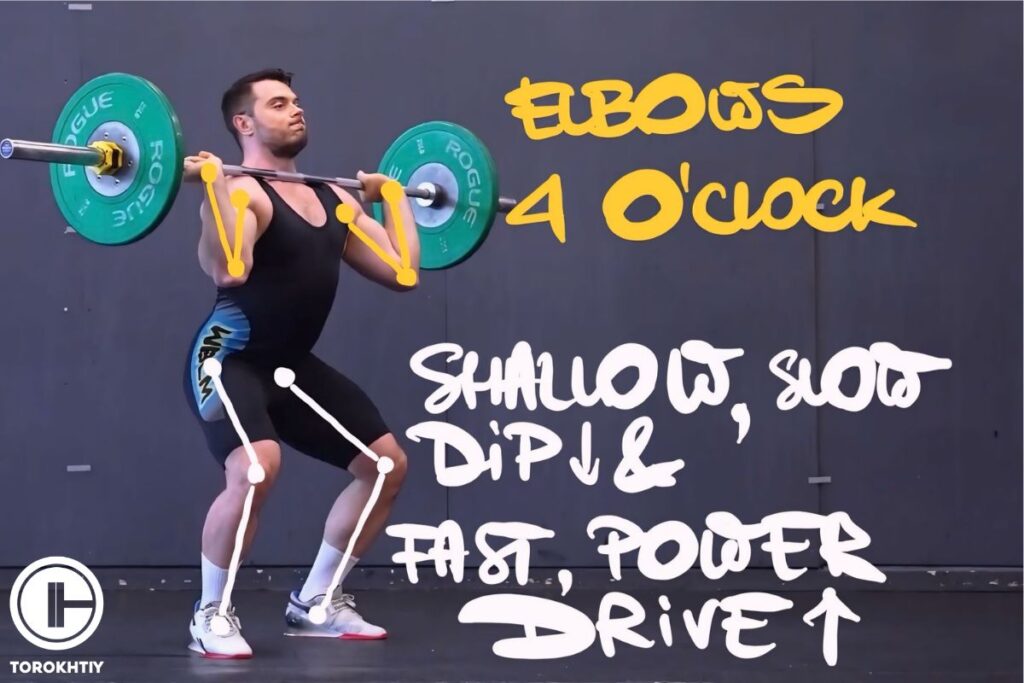
3. Drive
Going from the dip, explosively extend your legs to push the bar up. Use the power from your legs to drive the bar off your shoulders, fully extending your hips, knees and ankles to generate upward momentum.
The drive is where the power comes from, so focus on a strong, explosive movement to propel the bar up.
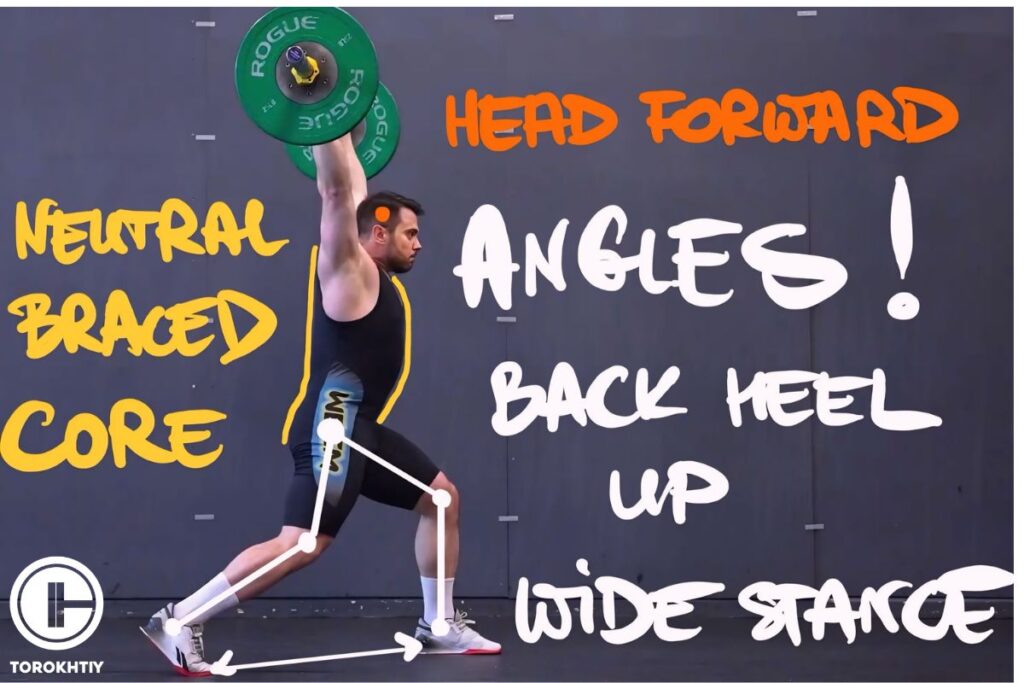
4. Split
As the bar leaves your shoulders, push yourself down from the bar and quickly split your legs into a lunge. Move your front foot forward and your back foot backward at the same time.
The goal is to get into a stable, balanced position with your front knee bent at about 110 degrees with your shin staying vertical and your back leg slightly bent. The width – aim for shoulder width or a bit wider stance to have proper base.
The split creates a stable base to catch and support the weight overhead.
5. Catch
Extend your arms completely overhead to catch the bar and lock your elbows to stabilize the weight directly above your shoulders and hips. Your head should be forward a little and you should be able to look straight ahead.
You want the bar to be aligned with your center of gravity for max stability.
6. Recovery
To complete the exercise, bring your feet back together in a controlled way, starting with your front foot. Stand up with the bar overhead and once you’re in a secure standing position, lower the barbell back to your shoulders or on the ground.
Nice job, you just did a split jerk!
Save it for easy access!
Bookmark this page now to access the program and instructional videos anytime, anywhere.
Stop wasting time searching during your gym sessions.
How to Program Split Jerk?
| Level | Reps | Sets | Frequency |
|---|---|---|---|
| Beginner | 3-5 | 3 | 2-3 times per week |
| Intermediate | 2-5 | 3-5 | 1-3 times a week |
| Advanced | 1-5 | 3-5 | As many times a week as you need |
Beginner
- Start with 3 sets of 3-5 reps per set
- Do the split jerk 2-3 times a week
- Master the split jerk form first, then add weight. Use an empty barbell or super light weights to practice form and build confidence. Once that’s done, you can add 5 to 10 pounds of weight.
Intermediate
- Do 3-5 sets of 2-5 reps per set
- Do the split jerk 1-3 times a week
- Start to increase your weight in 5 to 10-pound increments. It should be challenging to allow for progressive overload, but it shouldn’t mess up your form. Do accessory exercises like jerk drives and split stance presses
Advanced
- Do 3-5 sets of 1-5 reps per set
- Do the split jerk as many times a week as you need working on a quality that needs to be addressed – strength, power, speed etc.
- Use heavy weights and advanced techniques like pause jerks and heavy singles. Pay attention to recovery and rest to prevent injuries and allow your muscles to rest properly
Follow us!

Free!
Get a 2-week Weightlifting Program as a bonus for the subscription to kickstart your training plan!

Free!
4 Common Split Jerk Mistakes
Mistakes happen, they’re how we learn. But they’re still a bummer, so here are some common ones and ways to prevent them from happening.
❌ Shallow Dip
A shallow dip means you’re not bending your knees enough, so you lose power. Make sure to dip in a controlled way but deep enough, with your torso staying upright and your weight over your midfoot. Use pause jerks to solidify the correct depth.
❌ Uneven Split
If your feet aren’t split evenly, you’ll be off balance. You want around 110 degree bend in your front knee, but the shin must stay vertical and a slight bend in your back leg. Practice footwork drills to get your split even and consistent.
❌ Relying on Arms
Don’t use the strength of your arms to press the bar overhead, you want to use the power from your legs to drive the bar up, then lock out your arms quickly. This makes the lift safer.

❌ Too Narrow Stance
If your stance isn’t at least shoulder-width, balancing the weight side to side is going to be tough. Make sure your feet are properly spaced to stay stable and to maintain control throughout the lift. A wider stance will help distribute the weight evenly and it will prevent tipping or wobbling.

4 Benefits of Split Jerk
✅ Full-Body Strength
The split jerk works your legs, core, shoulders, and arms all at once. It’s a great way to build overall strength and power.
✅ More Power & Explosiveness
This lift is all about being quick and powerful. It helps you develop the ability to generate force fast, which is ideal if you’re an athlete and your performance depends on jumping, sprinting, throwing – anything that requires quick and explosive hip and knee extension.
Tips From the Champ
The split jerk is about balance and commitment. Focus on getting that front foot out fast and stable, while keeping your torso upright. The secret trick for the front foot is to push forward your heel. It will give your way more stability during landing. The faster you commit, the easier it is to stabilize the weight.
Olympic Weightlifting Champion
✅ Better Coordination & Balance
You need to coordinate your upper and lower body perfectly to nail the split jerk. Practicing it can improve your balance and make you more agile.
✅ Increased Stability
Holding a bar overhead in a split stance really works your core. A stronger core means better stability, performance, and less risk of back pain.
2 Split Jerk Variations
1. Split Jerk with Pause
You do a standard split jerk, but you pause just after the dip (in a shallow squat) to establish and solidify optimal depth of your dip. Hold for a few seconds and then move to aggressive drive. You can experiment with different depths to find the best one for you. It will also improve strength in that bottom position.
2. Behind-the-Neck Split Jerk
Start with the barbell resting on your traps behind the neck. This variation can improve shoulder flexibility and stability and give your muscles a different kind of stimulus. It’s good if you want to work on your overhead position.
It can also be an excellent variation for those of you who have problems with front rack position but still want to perform jerks.
2 Split Jerk Alternatives
1. Push Press
This is an exercise where you use your legs to help drive the bar overhead without the split stance. It’s simpler than the split jerk and focuses on building explosive power and shoulder strength.
2. Lunges with Bar Overhead
Hold a bar overhead with locked arms, step forward into a lunge while keeping the bar stable above your head, then go back to the starting position. This exercise boosts core stability, strengthens your shoulders, and overall balance. It’s also great for targeting leg muscles.
You have 2 options here as well – you can do walking lunges and go for distance or reps, or you can step forward and back if you’re limited by space. Both options are great so if you have the opportunity – try both.
Who Should Do the Split Jerk?
1. Weightlifters
Weightlifters, especially those in Olympic weightlifting, should do the split jerk to improve their clean and jerk performance. It helps them effectively lift heavier weights overhead.
2. Athletes
Athletes in sports like football, rugby, track and field, etc., will benefit from the split jerk because it will improve their ability to quickly generate force. This can give them a competitive edge.
Another great benefit from this exercise is that during one movement athletes can experience force production but also force absorption which is an important quality to train in any contact sports.
3. Functional Fitness Trainers
People who focus on functional fitness will love the split jerk because it can help improve everyday movements. It improves coordination and core stability, which makes everyday tasks easier but can also carry over to other exercises as well and make them better.
Muscles Worked by the Split Jerk
Well, just saying “a lot” doesn’t really mean much, right? We’ll be more specific but you should know, it’s a lot.
The split jerk targets your legs mostly, especially the quads, hamstrings, and glutes, for the initial push. Then, your shoulders, triceps, and upper chest take over during the press and lockout. Your core, including the abs and obliques, keep your body stable during the lift. Your calves and lower back play a big role in maintaining balance and support.
See? It’s a lot. This is why the split jerk is such an effective, full-body exercise.
Conclusion
To say that the split jerk packs a punch would be a tragic understatement. This is a true powerhouse exercise that builds strength, power, and coordination. You could be a pro or a newbie and the split jerk would still be a great addition to your routine. And if you get tired of it, there are variations and alternatives to keep things interesting!
Just remember that form should be your priority because it keeps you safe, and the weights you lift should never be so heavy that they mess up your split jerk technique.
Have you tried the split jerk? What’s your favorite variation?
Share your thoughts, questions, tips, and anything else you can think of in the comments!
Splitting off! (not literally)
Also Read:
- CLEAN & JERK
- Power Jerk
- Push Jerk
- My Top 3 Exercises for the Split Jerk Stability
- Top 3 Exercises for Jerk Dip & Drive
- Snatch vs Clean & Jerk
References:
- Becks Shepherd “Why are rest days important?” LiveScience, https://www.livescience.com/why-are-rest-days-important (accessed July 30th, 2024)
- Daniel Plotkin, Max Coleman, Derrick Van Every, Jaime Maldonado, Douglas Oberlin, Michael Israetel, Jared Feather, Andrew Alto, Andrew D. Vigotsky, Brad J. Schoenfeld, “Progressive Overload Without Progressing Load? The Effects of Load or Repetition Progression on Muscular Adaptations,” PeerJ 10 (2022): e14142.
- Health Promotion Board (HPB) “Prevent Injuries with Proper Form During Workouts,” Singapore University Health Center, https://www.nus.edu.sg/uhc/articles/details/prevent-injuries-with-proper-form-during-workouts (accessed July 30th 2024)
- Kuan Dong, Tenghao Yu, Buongo Chun “Effects of Core Training on Sport-Specific Performance of Athletes: A Meta-Analysis of Randomized Controlled Trials,” Behavioral Sciences 13, no. 2 (2023): 148.
- Zachary Smrcina, Sarah Woelfel, Christopher Burcal “A Systematic Review of the Effectiveness of Core Stability Exercises in Patients with Non-Specific Low Back Pain,” International Journal of Sports Physical Therapy 17, no. 5 (2022): 766-774. eCollection 2022.
- Photos by Torokhtiy Media Team.
Why Trust Us?
With over 20 years in Olympic weightlifting, strength training, nutrition coaching, and general fitness our team does its best to provide the audience with ultimate support and meet the needs and requirements of advanced athletes and professional lifters, as well as people who strive to open new opportunities and develop their physical capabilities with us.
By trusting the recommendations of our certified experts in coaching, nutrition, and sports training programming, as well as scientific consultants, and physiotherapists, we provide you with thorough, well-considered, and scientifically proven content. All the information given in the articles concerning workout programming, separate exercises, and athletic performance, in general, is based on verified data.
The product testing process is described in more detail here.
Author: Oleksiy Torokhtiy
Olympic Weightlifting Champion
Best Results: Snatch – 200 kg,
C&J – 240 kg
Oleksiy Torokhtiy is a professional athlete boasting 20 years of experience in Olympic weightlifting. With multiple European and World titles under his belt, he has showcased his prowess in two Olympic Games (Beijing 2008 and London 2012). Upon concluding his illustrious career, Oleksiy dedicated himself to coaching. By 2022, he had conducted over 200 weightlifting seminars worldwide. He is the visionary behind an international sportswear and accessories brand known for its motto, “Warm Body Cold Mind.” Additionally, he is an esteemed author and the creator of a series of training programs and eBooks.




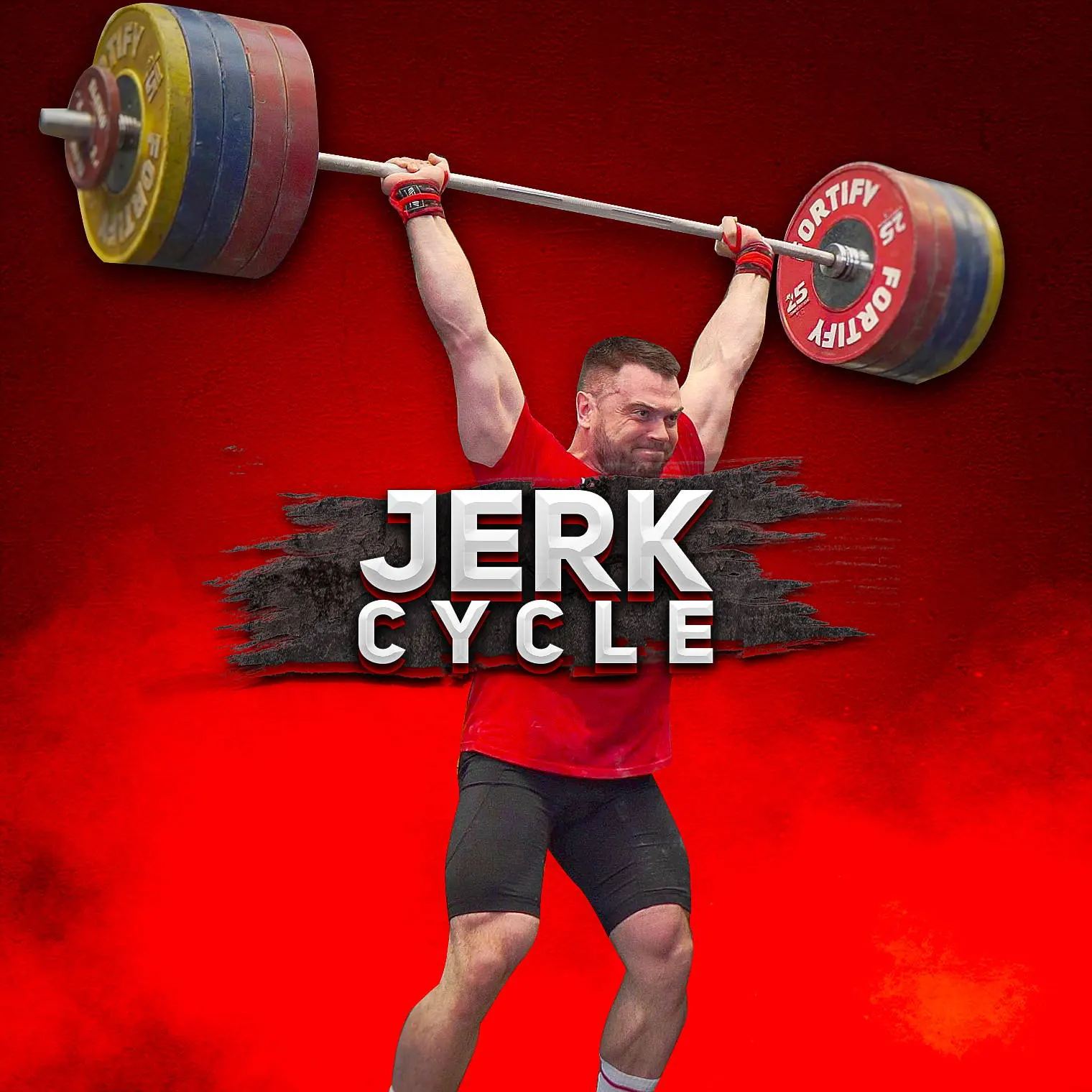
Still have questions after reading our article? Unlock your full potential by engaging with our experts and community! Don’t hesitate — leave a comment below and Oleksiy Torokhtiy will provide a personalized answer and insights to help you reach your goals.